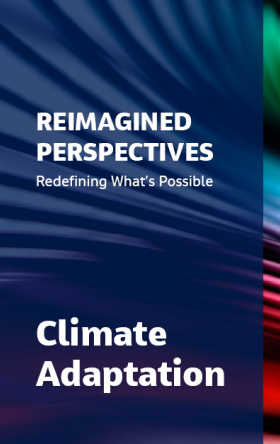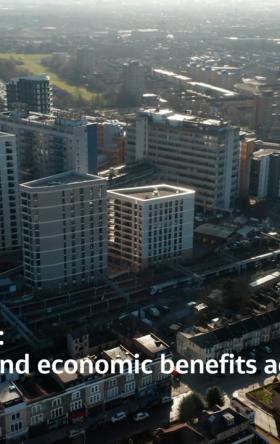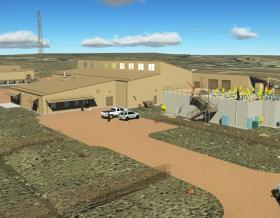




At Jacobs, we're challenging today to reinvent tomorrow by solving the world's most critical problems for thriving cities, resilient environments, mission-critical outcomes, operational advancement, scientific discovery and cutting-edge manufacturing, turning abstract ideas into realities that transform the world for good. With approximately $16 billion in annual revenue and a talent force of more than 60,000, Jacobs provides a full spectrum of professional services including consulting, technical, scientific and project delivery for the government and private sector.



For more than 70 years, our teams have provided integrated solutions to help solve the most complex and hazardous challenges of space exploration. We invent by imagining what’s possible.



A curated selection of some of the top-listened to and trending podcast episodes from our popular If/When podcast series, which has over 6M downloads to date.



Sit down with our visionary team of thinkers, dreamers and doers to see what a day in the life is like.
2c4e.jpg?h=c7c14dee&itok=FmPI2126)


As our clients navigate the digital transformation and growing cyber risks, we have positioned ourselves at the forefront of this growth, adding digital capabilities, products and tools to serve a growing set of customers.



Together with our visionary partner, PA Consulting, we're establishing our position in high end advisory services, creating a springboard to expand in high value offerings beyond the core.



The only certainty about the future is uncertainty. Resilience is an attribute of a smarter planet, and requires planning and adapting ahead of potential threats. We help our clients survive, recover, adapt and thrive.



Jacobs. A world where you can.



As a purpose-led company, we know we have a pivotal role to play in addressing the climate emergency. We consider this not only good business, but our duty to channel our technology-enabled expertise and capabilities toward benefitting people and the planet.



For more than 30 years, Jacobs has been responsible for planning and implementing Lead and Copper Rule-related strategies which protect millions of people in the U.S. and Canada. Our work includes enhanced water quality monitoring strategies, sampling plan development, harvested pipe-scale analysis, lead service line inventories and replacement plans, corrosion control studies and the incorporation of equity and environmental justice considerations into compliance programs.

_0ac2b.jpg?h=8a6d63f3&itok=5vsqFiQH)

Jacobs is working to help clients across the United States secure federal funding for projects that make our cities and communities more connected and sustainable. Working hand-in-hand with clients from coast to coast and everywhere in between, Jacobs develops bold, innovative solutions to address the nation’s toughest challenges.



Now more than ever, we appreciate the hard work, sacrifice and dedication of the medical profession in ensuring the health and safety of our communities.



Together, we are stronger. Together, we can transform the future.


2747.png?h=1314d3d4&itok=rFs9mG95)
We work in partnership, delivering some of the most challenging, diverse and innovative projects and programs globally across multiple sectors. We integrate complex interfaces across planning, procurement and delivery to help unlock better social, environmental and economic outcomes from mega and giga projects.



We’ve provided design-build services to the water sector for over 25 years and delivered more than 150 projects. We offer fully integrated design-build and design-build-operate capabilities to tackle the most complex water challenges and work in close collaboration with our clients.



As climate change threatens water security around the world, more communities are turning to water reuse as a resilient water supply solution and embracing the OneWater principle that all water has value. Jacobs has been supporting clients with water reuse programs for decades, beginning with the first applications of advanced wastewater treatment technologies in the 1960s. We provide our clients with a full range of services, from water reuse feasibility studies to design, construction and operations.



Jacobs’ deep experience with advanced technology systems and our wide-ranging program support capabilities make us a premier partner at locations across the world. We deliver the right talent, tools and processes to support and enable our customers’ missions.



The National Air and Space Museum's One World Connected exhibit will tell the story of how flight fostered two momentous changes in everyday life: the ease in making connections across vast distances and a new perspective of Earth as humanity’s home. Below are some stories from Jacobs that also highlight the connections and digital solutions we are making around the world.



Stories that capture our partnerships and innovative impact for a more connected, sustainable world


dd05.jpg?itok=zE9gl3KS)
Out now! We’ve teamed up with the Royal Scottish Geographical Society for The Geographer Special COP26 Edition. In an article for this special series, Jacobs’ Associate Director of Sustainability (Natural Capital), Penny Borton, and Sustainability Consultant in Natural Capital Approaches, Darren Grafius discuss the need for a renewed and active focus on society’s relationship with nature, and how to practically identify opportunities.
It is now widely accepted that humanity faces a climate emergency. The latest report from the Intergovernmental Panel on Climate Change (IPCC1) has heightened current awareness of the severity of the threat and the ever-worsening consequences of insufficient action.
Since the pre-industrial period, the average surface temperature of the Earth has risen by 1°C2 and atmospheric CO2 levels by 50%3. Concurrent with this is an associated ecological crisis. In the UK alone, a quarter of mammal species are under threat of extinction4. Yet in our well-intended response, our handling of one crisis may neglect another. For example, climate change mitigation efforts may focus on the protection of high-carbon ecosystems whilst overlooking biodiversity value. As such, biodiversity and climate objectives may be in poor agreement or even conflict. Increasingly, our planet is in desperate need of solutions with co-benefits for climate mitigation, biodiversity and wider natural capital gains.
Working with natural systems to address societal challenges and provide benefits for both human wellbeing and biodiversity, nature-based solutions can provide cost-effective approaches to mitigating and adapting to climate change. They offer the possibility of “win-win” scenarios that address climate goals while preserving or enhancing biodiversity. Biodiversity underpins the value we gain from the natural environment, including carbon storage and sequestration, so effective management is essential.
A growing consensus among scientists, practitioners and policy makers has identified the potential for nature-based solutions to play a major role in achieving net-zero targets5. Reaching net-zero – a state where all greenhouse gas emissions to the atmosphere are offset by equal or greater amounts of removal from the atmosphere – is a matter of both emission reduction and removals.
An example of nature-based emissions reductions could be the restoration of degraded peatlands, lessening CO2 emissions. Emission removals could include the creation of new woodlands which absorb carbon from the atmosphere and store it within tree biomass and soils. Carbon reductions and removals are both crucial for responding to the threats posed by climate change, addressing the gap between decarbonization efforts and net-zero targets, whilst providing additional ecosystem services to society.
The importance of blue carbon, carbon stored in coastal and marine ecosystems, is an increasing area of focus owing to the potential for significant carbon storage capacity. These ecosystems are frequently biodiversity hot spots and can store carbon at a greater density than terrestrial forests but can be fragile and easily degraded6. As such, they represent important mechanisms for the management of both the climate and ecological crises, whilst also providing wider societal benefits.
England's Environment Agency sees multiple benefits from nature-based solutions
At the center of many projects harnessing nature-based solutions to meet net-zero targets is the question of how to practically identify opportunities. England’s Environment Agency has committed to a 2030 net-zero carbon target consisting of a 45% reduction in emissions, with remaining emissions to be addressed by carbon offsetting7. To identify the most effective and practical nature-based offsetting methods, Jacobs has been working with the Environment Agency in North West England to develop a robust site-selection model to find suitable sites for habitat restoration and creation which provide carbon offset benefits. Together we are working with stakeholders to identify partnership working opportunities and prioritize them based on a multi-criteria analysis, to derive the greatest social value.
David Brown, Senior Flood Risk Management Advisor with the Environment Agency, said: “The Environment Agency’s flood defense program is a fantastic example of adaptation in action and can be seen by those attending the COP26 climate talks in Glasgow.
“Using nature-based solutions in combination with other measures such as traditional engineered flood and coastal defenses, is one way we are driving down flood risk, and reducing our carbon footprint. The multiple benefits we see from nature-based solutions is an important part of the long-term vision set out in our Flood and Coastal Risk Management Strategy - ensuring today’s growth and infrastructure is resilient to tomorrow’s climate.”
Diverse and equitable benefits
Nature-based solutions are a relatively new approach, and so face several challenges to adoption, including reliability and cost-effectiveness. However, recent research in multiple contexts has indicated that diverse benefits far outweigh implementation and management costs. Current evidence for cost-effectiveness also shows a tendency to underestimate ecosystem service benefits.
Additionally, the interdisciplinary character of nature-based solutions and the equitable sharing of benefits between multiple stakeholders can raise questions of ownership. While this may require adjustment from conventional approaches, cooperation and shared investment between organizations, communities and governments should be encouraged. While proven examples are limited, this highlights the novelty of nature-based solutions and makes this the right time to explore them and reap the benefits8.
Out of COP26 there must be a renewed and active focus on society’s relationship with nature. Faced with the need to meet net-zero targets and preserve an ecologically threatened world, it is upon us all to commit to solutions that offer a sustainable path toward achieving both.
Image: Jeremy Halls
1 https://www.ipcc.ch/report/ar6/wg1/
2https://www.ipcc.ch/sr15/faq/faq-chapter-1/
5https://www.water.org.uk/routemap2030/
6 https://www.nature.com/articles/d41586-021-01241-2
8https://www.iucn.org/resources/issues-briefs/blue-carbon
9https://www.gov.uk/government/publications/environment-agency-reaching-net-zero-by-2030
10 Seddon Nathalie, Chausson Alexandre, Berry Pam, Girardin Cécile A. J., Smith Alison and Turner Beth 2020. Understanding the value and limits of nature-based solutions to climate change and other global challenges. Phil. Trans. R. Soc. B37520190120